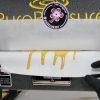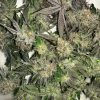Pressing bubble hash into rosin isn’t complicated—you put bubble hash in a rosin bag and press it between heated plates until rosin seeps out—but to really harness the potential of your extract and create SKUs people will pay top prices for, there are a few tricks that are helpful to know.
From your starting material to the temperature of your working environment, pressing temps, pressing times, and post-extraction processing, optimizing the finer details of bubble-hash-to-rosin extraction can be the difference between an average concentrate and a premium one.
Bubble Hash to Rosin: Quick Guide
You will need:
- Freeze-dried ice water hash
- A rosin press
- Rosin bags
- Food-grade parchment paper (please note: this is different from wax paper)
- Nitrile gloves
- Optional but suggested: a cold environment in which to work, such as a cold room or walk-in freezer
Method:
- Put on the nitrile gloves.
- Cover the plates on the rosin press with parchment paper to make the rosin collection easier.
- Heat the plates to the lower end of the temperature range. Bubble hash is usually pure enough for cold pressing, so start with a temperature between 140°F and 200°F and experiment with rises of 10-15°F for subsequent batches to see which temp gives you the best result.
- Put your freeze-dried ice water hash in the rosin bags and place the bags between the heated plates. Some people like to use more than one rosin bag (i.e. double-bag), but a single bag is usually sufficient as long as you choose an appropriate micron size. For pressing bubble hash, we recommend using a 25μm or 36μm-micron bag.
- Press the plates together to squeeze out the rosin. If you’re cold pressing, use intervals of 1 to 4 minutes. For temperatures above 180°F, short intervals of 45 seconds to 3 minutes are best.
- With gloved hands, remove the parchment paper from the hot plates and use a collection tool to scrape the rosin into an airtight glass jar such as a sealable Ball jar or similar. Some people find that using a cold plate makes this step easier.
At this point, you can gram the rosin out at the lab or process it further with whipping and warm or cold curing. However, as far as turning bubble hash into rosin goes, those six steps are all you need to know.
How to Create Six-Star Live Rosin Extracts from Bubble Hash
We’ve covered the basics of bubble hash rosin pressing. But if you really want to create a product people will pay top dollar for—or you want to manufacture a wider range of products with your rosin—there are a few more things you can do to set your extracts apart.
Start with Premium Buds
Premium bubble hash rosin begins with premium starting material. When choosing cannabis flowers for your bubble hash, look for buds with large trichome heads in the 72µm to 120µm range that are easy to detach from the bud.
In general, cookie, cake, chem, and pie strains are great for making extracts—especially if they’re grown in a greenhouse or indoor grow room rather than outdoors. When it comes time to make ice water hash, you can use the whole buds or the trim if you trim the buds fresh-frozen rather than dried. Bubble hash is a great use for wet trim.
Use Fresh Frozen Cannabis
After harvesting the cannabis flowers, remove the fan leaves and freeze the buds right away to lock in the colors, cannabinoids, and terpene content. Then, you can either trim the buds if you’re planning on using the trim to make extracts, or go straight to ice water extraction. In both cases, you can maintain the cold chain and make the whole process much easier and quicker by using The Original Resinator.
For the best live bubble hash, we would always recommend using The Original Resinator both for trimming your buds and creating your ice water extracts. Aside from saving you time agitating the ice water manually (the rotating horizontal cylinder does all the work), the sugar leaves fracture and fall off cleanly during the cryo-trimming process without becoming contaminated with chlorophyll. The resulting trim is rich, full-bodied, and ideal for creating four and five-star concentrates.
Make Ice Water Hash
If you use the Original Resinator to extract the gold from your buds or trim, simply fill the drum with ice-cold water, place your fresh frozen buds or trim in the drum, secure one of our mesh collection bags under the drain plug, and let the buds sit for 20 minutes or so.
Then, as the drum turns, the trichomes will collect in the bag under the plug, ready to be scraped into a container. Once this process is complete, put the wet ice water hash straight in a freeze dryer to remove the moisture and store it in airtight containers until you’re ready to press.
Use Low Pressing Temperatures
If you’ve followed the cold chain concept correctly, you should have a very high-quality live bubble hash that you can now convert into live rosin. Now, to protect the terpenes, you’ll want to press hash rosin using lower temperatures on your rosin press (more on this below).
While cold pressing does result in a slightly lower volume of rosin, the quality is unparalleled. Some processors use cold pressing to create live extracts and hot pressing to achieve specific in-demand textures. It’s definitely worth experimenting to see what textures you can create.
Cold Pressing Hash Rosin
Cold pressing takes place at around 130°F and 170°F (the range we recommend when working with bubble hash) and produces rosin with a buttery or batter-like consistency. If you’re using a digital rosin press such as the Pikes Peak Press or Longs Peak Rosin Press, you can program the temperature and pressure you want on the digital interface and save these settings so that you can replicate your results.
Hot Pressing Hash Rosin
Pressing bubble hash at high temperatures is generally not recommended because you can get a better return on investment by reserving this kind of premium extract for live rosin. Hot temperatures are more common when pressing kief rosin.
However, if you want to make rosin with an oil or shatter consistency, you can press your ice water hash between 180°F and 200°F for short intervals between 45 seconds and 3 minutes. At temperatures above 200°F, the terpenes will start to degrade. At temperatures above 250°F, THC starts to convert to CBN. For these reasons, we don’t usually recommend going above 220°F.
Experiment with Temperatures and Times
As you experiment with different temperatures and pressing times, make a note of your settings and the results of each batch so that you can duplicate the temperature and pressing times that turned out the highest quality rosin.
While it’s often a matter of striking a balance between quality and yield, if you’ve followed our recommended practices starting from the quality of the plants themselves, you have the potential to create an extract that’s really top-shelf. At this point, any loss in yield will be more than offset by the premium price.
Create a Diverse Range of SKUs with Further Processing
Live rosin that’s been pressed correctly can be sold directly to dispensaries. However, with a little further processing, you can often enhance the flavor and create a wider range of product offerings.
Whipping
Whipping your rosin can change the consistency from sappy to buttery, which is ideal for extracts destined for dabbing. To whip your bubble hash rosin, stir it rapidly with a stirring implement or collection tool as soon as you’ve collected the rosin in a glass jar. Once you’re satisfied that you’ve whipped it thoroughly, put on the lid and leave it to cure.
Curing
Curing rosin can enhance the flavors of your extract and create a wide range of different textures.
Cold Curing
Cold curing is the most popular method because it preserves the bioactive components of the extract better than hot curing. This curing method results in badder-type extracts.
Keep the sealed extracts at room temperature (60°F and 70°F) for a few weeks or refrigerate them at 40°F for a few days to one week. Then leave them at room temperature for a few more weeks to finish curing.
Hot Curing
Hot curing—while slightly less common—can be used to create a much wider range of textures, including badder, sauce, sauce and diamonds, and rosin jam. This process can also be used to separate out the terpenes for rosin vape cartridges.
Hot curing happens at around 90°F to 120°F, and as long as you stick to this range, any terpene loss will be minimal. For a hot cure, keep the sealed jars in the oven at 90°F to 120°F for a few days up to a week or more until the desired consistency has been achieved. Then, leave the jars to cure at room temperature for a few more weeks before storing them in the fridge.
With The Right Processes, You Can Transform Bubble Hash into a Complete Line of Premium Extracts
Pressing bubble hash to make rosin is a simple process (arguably just as simple as making rosin from flower) that anyone can do with the right equipment. However, with top-quality starting materials, a versatile cryo-extraction machine like The Original Resinator, and a little experimentation with temps and times, you can fine-tune your process to create some really phenomenal solventless extracts. Did you know you can make all kinds of SKUs from your bubble hash and rosin? Make sure to take a look at our Product Pathways chart for some ideas.
After creating live rosin, further processing such as whipping and cold or hot curing offers a wealth of marketing opportunities in terms of textures that consumers would typically look for in hydrocarbon extracts. From a single manual cannabis separation—bubble hash—you can create an entire line of premium SKUs that connoisseurs will pay top dollar to buy.





